Lincoln Electric LF-72, IM847-D User Manual
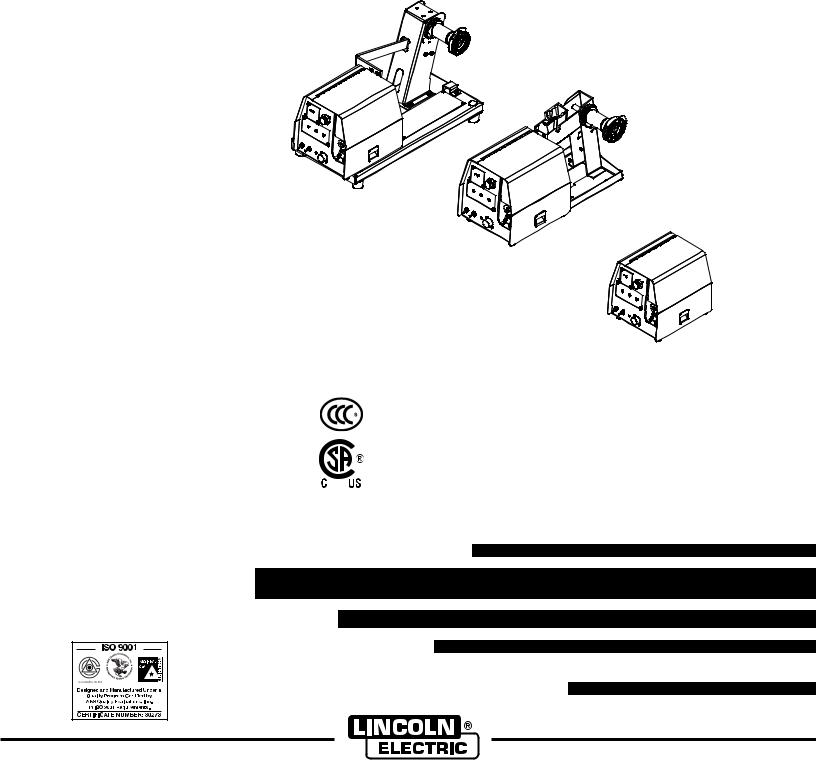
RETURN TO MAIN MENU |
|
IM847-D |
|
|
|
LF-72 WIRE FEEDER |
March, 2010 |
|
|
||
For use with machines having Code Numbers: 11075, 11076, |
11077 |
|
11209, 11210, |
11211, 11227 |
|
11290, 11291, |
11292, 11293 |
|
11606, 11607, |
11608, 11609 |
|
11708, 11709, |
11710, 11711 |
|
Safety Depends on You
Lincoln arc welding and cutting equipment is designed and built with safety in mind. However, your overall safety can be increased by proper installation ...
and thoughtful operation on your part. DO NOT INSTALL, OPER-
ATE OR REPAIR THIS EQUIPMENT WITHOUT READING THIS MANUAL AND THE SAFE-
TY PRECAUTIONS CONTAINED THROUGHOUT. And, most importantly, think before you act and be careful.
IP21
IEC 60974-5
OPERATOR’S MANUAL
Copyright © Lincoln Global Inc.
•World's Leader in Welding and Cutting Products •
•Sales and Service through Subsidiaries and Distributors Worldwide •
Cleveland, Ohio 44117-1199 U.S.A. TEL: 1.888.935.3877 FAX: 216.486.1751 WEB SITE: www.lincolnelectric.com
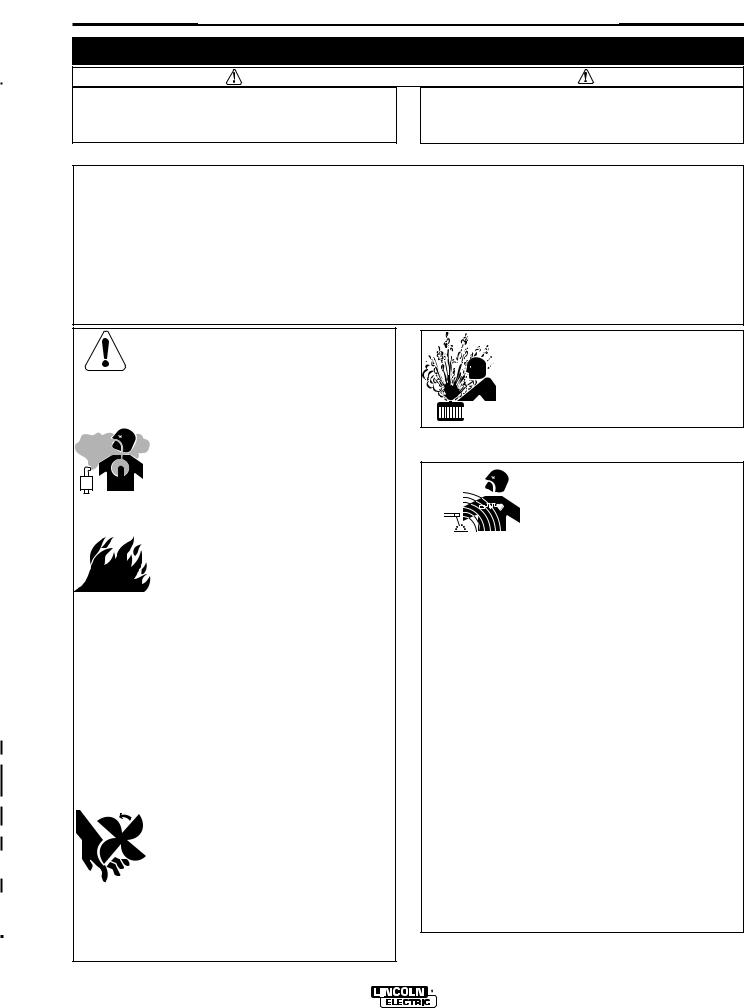
i
SAFETY
i
 WARNING
WARNING
CALIFORNIA PROPOSITION 65 WARNINGS
Diesel engine exhaust and some of its constituents are known to the State of California to cause cancer, birth defects, and other reproductive harm.
The Above For Diesel Engines
The engine exhaust from this product contains chemicals known to the State of California to cause cancer, birth defects, or other reproductive harm.
The Above For Gasoline Engines
ARC WELDING CAN BE HAZARDOUS. PROTECT YOURSELF AND OTHERS FROM POSSIBLE SERIOUS INJURY OR DEATH. KEEP CHILDREN AWAY. PACEMAKER WEARERS SHOULD CONSULT WITH THEIR DOCTOR BEFORE OPERATING.
Read and understand the following safety highlights. For additional safety information, it is strongly recommended that you purchase a copy of “Safety in Welding & Cutting - ANSI Standard Z49.1” from the American Welding Society, P.O. Box 351040, Miami, Florida 33135 or CSA Standard W117.2-1974. A Free copy of “Arc Welding Safety” booklet E205 is available from the Lincoln Electric Company, 22801 St. Clair Avenue, Cleveland, Ohio 44117-1199.
BE SURE THAT ALL INSTALLATION, OPERATION, MAINTENANCE AND REPAIR PROCEDURES ARE PERFORMED ONLY BY QUALIFIED INDIVIDUALS.
FOR ENGINE powered equipment.
1.a. Turn the engine off before troubleshooting and maintenance work unless the maintenance work requires it to be running.
____________________________________________________
1.b. Operate engines in open, well-ventilated areas or vent the engine exhaust fumes
outdoors.
____________________________________________________
1.c. Do not add the fuel near an open flame welding arc or when the engine is running.
Stop the engine and allow it to cool before refueling to prevent spilled fuel from vaporizing on contact with hot engine parts and igniting. Do not spill fuel when filling tank. If fuel is spilled, wipe it up and do not start engine until fumes have been eliminated.
____________________________________________________
1.d. Keep all equipment safety guards, covers and devices in position and in good repair.Keep hands, hair, clothing and tools away from V-belts, gears, fans and all other moving parts when starting, operating or repairing equipment.
____________________________________________________
1.e. In some cases it may be necessary to remove safety guards to perform required maintenance. Remove guards only when necessary and replace them when the maintenance requiring their removal is complete. Always use the greatest care when working near moving parts.
___________________________________________________
1.f. Do not put your hands near the engine fan. Do not attempt to override the governor or idler by pushing on the throttle control rods
while the engine is running.
___________________________________________________
1.g. To prevent accidentally starting gasoline engines while turning the engine or welding generator during maintenance work, disconnect the spark plug wires, distributor cap or magneto wire as appropriate.
1.h. To avoid scalding, do not remove the radiator pressure cap when the engine is hot.
ELECTRIC AND MAGNETIC FIELDS may be dangerous
2.a. Electric current flowing through any conductor causes localized Electric and Magnetic Fields (EMF). Welding current creates EMF fields around welding cables and welding machines
2.b. EMF fields may interfere with some pacemakers, and welders having a pacemaker should consult their physician before welding.
2.c. Exposure to EMF fields in welding may have other health effects which are now not known.
2.d. All welders should use the following procedures in order to minimize exposure to EMF fields from the welding circuit:
2.d.1. Route the electrode and work cables together - Secure them with tape when possible.
2.d.2. Never coil the electrode lead around your body.
2.d.3. Do not place your body between the electrode and work cables. If the electrode cable is on your right side, the work cable should also be on your right side.
2.d.4. Connect the work cable to the workpiece as close as possible to the area being welded.
2.d.5. Do not work next to welding power source.
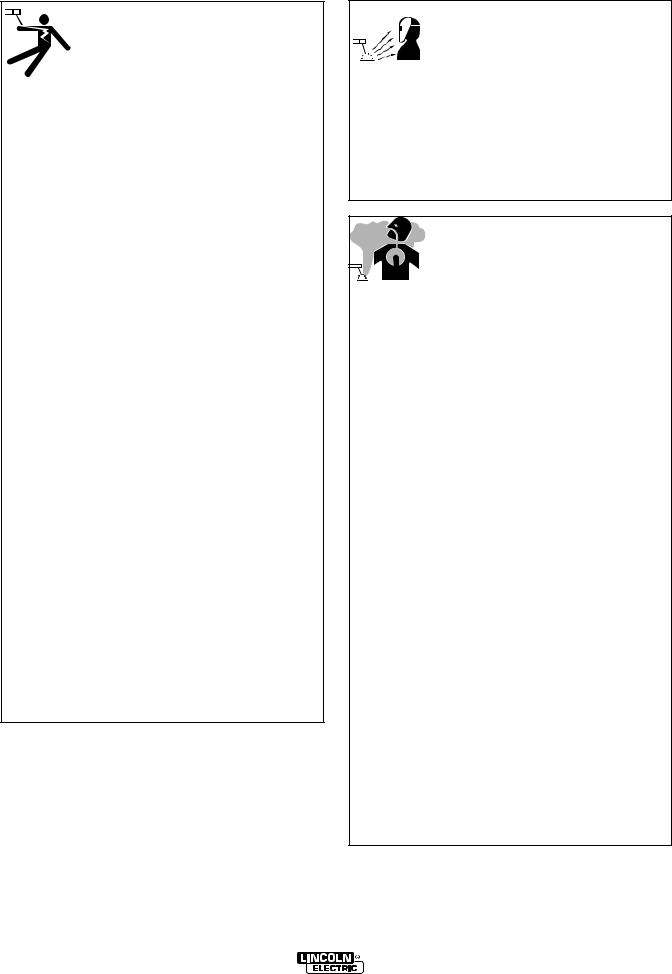
ii |
|
SAFETY |
|
ii |
|
|
|
|
|
|
|
|
|
|
ELECTRIC SHOCK can
kill.
3.a. The electrode and work (or ground) circuits are electrically “hot” when the welder is on. Do not touch these “hot” parts with your bare skin or wet clothing. Wear dry, hole-free
gloves to insulate hands.
3.b. Insulate yourself from work and ground using dry insulation. Make certain the insulation is large enough to cover your full area of physical contact with work and ground.
In addition to the normal safety precautions, if welding must be performed under electrically hazardous conditions (in damp locations or while wearing wet clothing; on metal structures such as floors, gratings or scaffolds; when in cramped positions such as sitting, kneeling or lying, if there is a high risk of unavoidable or accidental contact with the workpiece or ground) use the following equipment:
•Semiautomatic DC Constant Voltage (Wire) Welder.
•DC Manual (Stick) Welder.
•AC Welder with Reduced Voltage Control.
3.c. In semiautomatic or automatic wire welding, the electrode, electrode reel, welding head, nozzle or semiautomatic welding gun are also electrically “hot”.
3.d. Always be sure the work cable makes a good electrical connection with the metal being welded. The connection should be as close as possible to the area being welded.
3.e. Ground the work or metal to be welded to a good electrical (earth) ground.
3.f. Maintain the electrode holder, work clamp, welding cable and welding machine in good, safe operating condition. Replace damaged insulation.
3.g. Never dip the electrode in water for cooling.
3.h. Never simultaneously touch electrically “hot” parts of electrode holders connected to two welders because voltage between the two can be the total of the open circuit voltage of both welders.
3.i. When working above floor level, use a safety belt to protect yourself from a fall should you get a shock.
3.j. Also see Items 6.c. and 8.
ARC RAYS can burn.
4.a. Use a shield with the proper filter and cover plates to protect your eyes from sparks and the rays of the arc when welding or observing open arc welding. Headshield and filter lens should conform to ANSI Z87. I standards.
4.b. Use suitable clothing made from durable flame-resistant material to protect your skin and that of your helpers from the arc rays.
4.c. Protect other nearby personnel with suitable, non-flammable screening and/or warn them not to watch the arc nor expose themselves to the arc rays or to hot spatter or metal.
FUMES AND GASES
can be dangerous.
5.a. Welding may produce fumes and gases
hazardous to health. Avoid breathing these fumes and gases. When welding, keep your head out of the fume. Use enough ventilation and/or exhaust at the arc to keep
fumes and gases away from the breathing zone. When welding with electrodes which require special ventilation such as stainless or hard facing (see instructions on container or MSDS) or on lead or cadmium plated steel and other metals or coatings which produce highly toxic fumes, keep exposure as low as possible and within applicable OSHA PEL and ACGIH TLV limits using local exhaust or mechanical ventilation. In confined spaces or in some circumstances, outdoors, a respirator may be required. Additional precautions are also required when welding on galvanized steel.
5.b. The operation of welding fume control equipment is affected by various factors including proper use and positioning of the equipment, maintenance of the equipment and the specific welding procedure and application involved. Worker exposure level should be checked upon installation and periodically thereafter to be certain it is within applicable OSHA PEL and ACGIH TLV limits.
5.c. Do not weld in locations near chlorinated hydrocarbon vapors coming from degreasing, cleaning or spraying operations. The heat and rays of the arc can react with solvent vapors to form phosgene, a highly toxic gas, and other irritating products.
5.d. Shielding gases used for arc welding can displace air and cause injury or death. Always use enough ventilation, especially in confined areas, to insure breathing air is safe.
5.e. Read and understand the manufacturer’s instructions for this equipment and the consumables to be used, including the material safety data sheet (MSDS) and follow your employer’s safety practices. MSDS forms are available from your welding distributor or from the manufacturer.
5.f. Also see item 1.b.
Jan ‘09
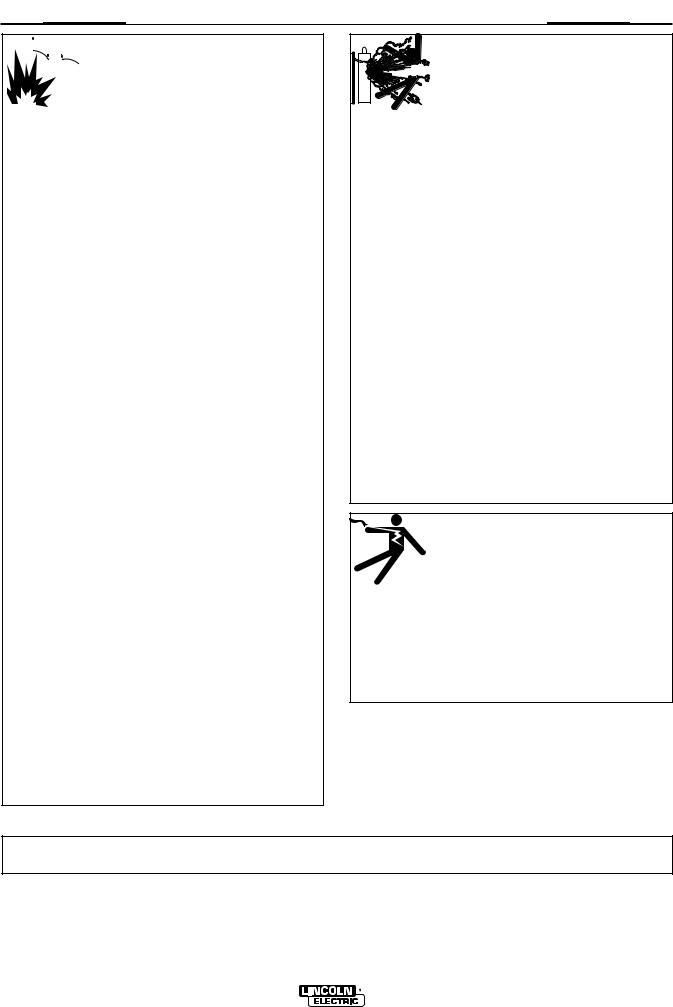
iii
SAFETY
iii



 WELDING and CUTTING
WELDING and CUTTING

 SPARKS can
SPARKS can
cause fire or explosion.
6.a. Remove fire hazards from the welding area. If this is not possible, cover them to prevent the welding sparks from starting a fire.
Remember that welding sparks and hot materials from welding can easily go through small cracks and openings to adjacent areas. Avoid welding near hydraulic lines. Have a fire extinguisher readily available.
6.b. Where compressed gases are to be used at the job site, special precautions should be used to prevent hazardous situations. Refer to “Safety in Welding and Cutting” (ANSI Standard Z49.1) and the operating information for the equipment being used.
6.c. When not welding, make certain no part of the electrode circuit is touching the work or ground. Accidental contact can cause overheating and create a fire hazard.
6.d. Do not heat, cut or weld tanks, drums or containers until the proper steps have been taken to insure that such procedures will not cause flammable or toxic vapors from substances inside. They can cause an explosion even though they have been “cleaned”. For information, purchase “Recommended
Safe Practices for the Preparation for Welding and Cutting of Containers and Piping That Have Held Hazardous
Substances”, AWS F4.1 from the American Welding Society
(see address above).
6.e. Vent hollow castings or containers before heating, cutting or welding. They may explode.
6.f. Sparks and spatter are thrown from the welding arc. Wear oil free protective garments such as leather gloves, heavy shirt, cuffless trousers, high shoes and a cap over your hair. Wear ear plugs when welding out of position or in confined places. Always wear safety glasses with side shields when in a welding area.
6.g. Connect the work cable to the work as close to the welding area as practical. Work cables connected to the building framework or other locations away from the welding area increase the possibility of the welding current passing through lifting chains, crane cables or other alternate circuits. This can create fire hazards or overheat lifting chains or cables until they fail.
6.h. Also see item 1.c.
6.I. Read and follow NFPA 51B “ Standard for Fire Prevention During Welding, Cutting and Other Hot Work”, available from NFPA, 1 Batterymarch Park, PO box 9101, Quincy, Ma 022690-9101.
6.j. Do not use a welding power source for pipe thawing.
CYLINDER may explode




 if damaged.
if damaged.
7.a. Use only compressed gas cylinders
containing the correct shielding gas for the process used and properly operating regulators designed for the gas and
pressure used. All hoses, fittings, etc. should be suitable for the application and maintained in good condition.
7.b. Always keep cylinders in an upright position securely chained to an undercarriage or fixed support.
7.c. Cylinders should be located:
•Away from areas where they may be struck or subjected to physical damage.
•A safe distance from arc welding or cutting operations and any other source of heat, sparks, or flame.
7.d. Never allow the electrode, electrode holder or any other electrically “hot” parts to touch a cylinder.
7.e. Keep your head and face away from the cylinder valve outlet when opening the cylinder valve.
7.f. Valve protection caps should always be in place and hand tight except when the cylinder is in use or connected for use.
7.g. Read and follow the instructions on compressed gas cylinders, associated equipment, and CGA publication P-l, “Precautions for Safe Handling of Compressed Gases in
Cylinders,” available from the Compressed Gas Association 1235 Jefferson Davis Highway, Arlington, VA 22202.
FOR ELECTRICALLY powered equipment.
8.a. Turn off input power using the disconnect switch at the fuse box before working on the equipment.
8.b. Install equipment in accordance with the U.S. National
Electrical Code, all local codes and the manufacturer’s recommendations.
8.c. Ground the equipment in accordance with the U.S. National Electrical Code and the manufacturer’s recommendations.
Refer to http://www.lincolnelectric.com/safety for additional safety information.
Jan ‘09
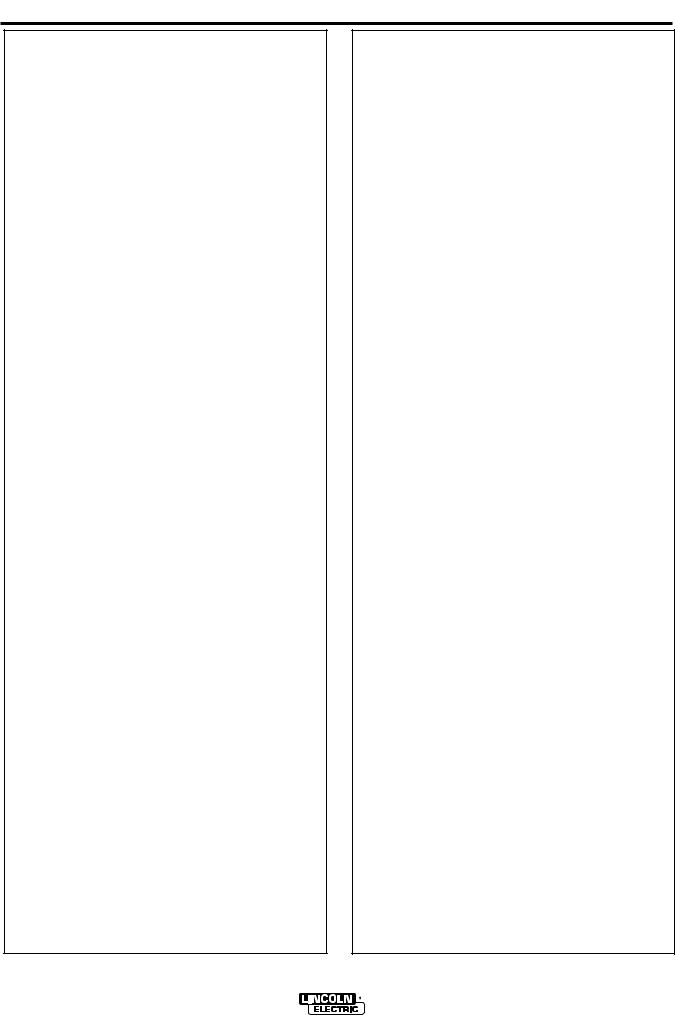
iv
SAFETY
iv
PRÉCAUTIONS DE SÛRETÉ
Pour votre propre protection lire et observer toutes les instructions et les précautions de sûreté specifiques qui parraissent dans ce manuel aussi bien que les précautions de sûreté générales suivantes:
Sûreté Pour Soudage A L’Arc
1.Protegez-vous contre la secousse électrique:
a.Les circuits à l’électrode et à la piéce sont sous tension quand la machine à souder est en marche. Eviter toujours tout contact entre les parties sous tension et la peau nue ou les vétements mouillés. Porter des gants secs et sans trous pour isoler les mains.
b.Faire trés attention de bien s’isoler de la masse quand on soude dans des endroits humides, ou sur un plancher metallique ou des grilles metalliques, principalement dans les positions assis ou couché pour lesquelles une grande partie du corps peut être en contact avec la masse.
c.Maintenir le porte-électrode, la pince de masse, le câble de soudage et la machine à souder en bon et sûr état defonctionnement.
d.Ne jamais plonger le porte-électrode dans l’eau pour le refroidir.
e.Ne jamais toucher simultanément les parties sous tension des porte-électrodes connectés à deux machines à souder parce que la tension entre les deux pinces peut être le total de la tension à vide des deux machines.
f.Si on utilise la machine à souder comme une source de courant pour soudage semi-automatique, ces precautions pour le porte-électrode s’applicuent aussi au pistolet de soudage.
2.Dans le cas de travail au dessus du niveau du sol, se protéger contre les chutes dans le cas ou on recoit un choc. Ne jamais enrouler le câble-électrode autour de n’importe quelle partie du corps.
3.Un coup d’arc peut être plus sévère qu’un coup de soliel, donc:
a.Utiliser un bon masque avec un verre filtrant approprié ainsi qu’un verre blanc afin de se protéger les yeux du rayonnement de l’arc et des projections quand on soude ou quand on regarde l’arc.
b.Porter des vêtements convenables afin de protéger la peau de soudeur et des aides contre le rayonnement de l‘arc.
c.Protéger l’autre personnel travaillant à proximité au soudage à l’aide d’écrans appropriés et non-inflammables.
4.Des gouttes de laitier en fusion sont émises de l’arc de soudage. Se protéger avec des vêtements de protection libres de l’huile, tels que les gants en cuir, chemise épaisse, pantalons sans revers, et chaussures montantes.
5.Toujours porter des lunettes de sécurité dans la zone de soudage. Utiliser des lunettes avec écrans lateraux dans les zones où l’on pique le laitier.
6.Eloigner les matériaux inflammables ou les recouvrir afin de prévenir tout risque d’incendie dû aux étincelles.
7.Quand on ne soude pas, poser la pince à une endroit isolé de la masse. Un court-circuit accidental peut provoquer un échauffement et un risque d’incendie.
8.S’assurer que la masse est connectée le plus prés possible de la zone de travail qu’il est pratique de le faire. Si on place la masse sur la charpente de la construction ou d’autres endroits éloignés de la zone de travail, on augmente le risque de voir passer le courant de soudage par les chaines de levage, câbles de grue, ou autres circuits. Cela peut provoquer des risques d’incendie ou d’echauffement des chaines et des câbles jusqu’à ce qu’ils se rompent.
9.Assurer une ventilation suffisante dans la zone de soudage. Ceci est particuliérement important pour le soudage de tôles galvanisées plombées, ou cadmiées ou tout autre métal qui produit des fumeés toxiques.
10.Ne pas souder en présence de vapeurs de chlore provenant d’opérations de dégraissage, nettoyage ou pistolage. La chaleur ou les rayons de l’arc peuvent réagir avec les vapeurs du solvant pour produire du phosgéne (gas fortement toxique) ou autres produits irritants.
11.Pour obtenir de plus amples renseignements sur la sûreté, voir le code “Code for safety in welding and cutting” CSA Standard W 117.2-1974.
PRÉCAUTIONS DE SÛRETÉ POUR LES MACHINES À SOUDER À TRANSFORMATEUR ET À REDRESSEUR
1.Relier à la terre le chassis du poste conformement au code de l’électricité et aux recommendations du fabricant. Le dispositif de montage ou la piece à souder doit être branché à une bonne mise à la terre.
2.Autant que possible, I’installation et l’entretien du poste seront effectués par un électricien qualifié.
3.Avant de faires des travaux à l’interieur de poste, la debrancher à l’interrupteur à la boite de fusibles.
4.Garder tous les couvercles et dispositifs de sûreté à leur place.
Mar. ‘93
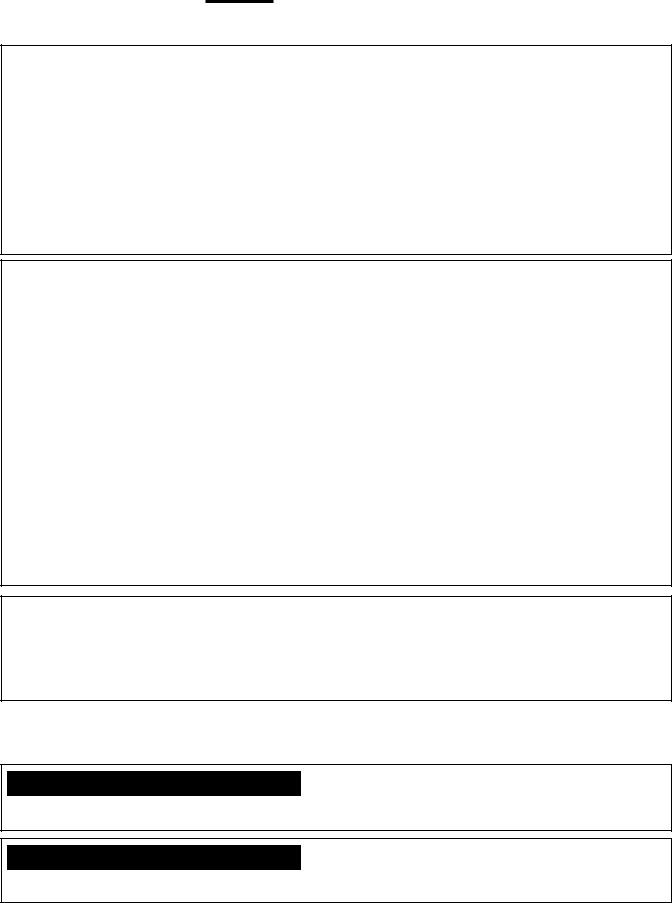
v |
TABLE OF CONTENTS |
v |
Thank You |
••• as much pride as we have in bringing this product to you! |
|
|
for selecting a QUALITY product by Lincoln Electric. We want you |
|
to take pride in operating this Lincoln Electric Company product
CUSTOMER ASSISTANCE POLICY
The business of The Lincoln Electric Company is manufacturing and selling high quality welding equipment, consumables, and cutting equipment. Our challenge is to meet the needs of our customers and to exceed their expectations. On occasion, purchasers may ask Lincoln Electric for advice or information about their use of our products. We respond to our customers based on the best information in our possession at that time. Lincoln Electric is not in a position to warrant or guarantee such advice, and assumes no liability, with respect to such information or advice. We expressly disclaim any warranty of any kind, including any warranty of fitness for any customer’s particular purpose, with respect to such information or advice. As a matter of practical consideration, we also cannot assume any responsibility for updating or correcting any such information or advice once it has been given, nor does the provision of information or advice create, expand or alter any warranty with respect to the sale of our products.
Lincoln Electric is a responsive manufacturer, but the selection and use of specific products sold by Lincoln Electric is solely within the control of, and remains the sole responsibility of the customer. Many variables beyond the control of Lincoln Electric affect the results obtained in applying these types of fabrication methods and service requirements.
Subject to Change – This information is accurate to the best of our knowledge at the time of printing. Please refer to www.lincolnelectric.com for any updated information.
Please Examine Carton and Equipment For Damage Immediately
When this equipment is shipped, title passes to the purchaser upon receipt by the carrier. Consequently, Claims for material damaged in shipment must be made by the purchaser against the transportation company at the time the shipment is received.
Please record your equipment identification information below for future reference. This information can be found on your machine nameplate.
Product _________________________________________________________________________________
Model Number ___________________________________________________________________________
Code Number or Date Code_________________________________________________________________
Serial Number____________________________________________________________________________
Date Purchased___________________________________________________________________________
Where Purchased_________________________________________________________________________
Whenever you request replacement parts or information on this equipment, always supply the information you have recorded above. The code number is especially important when identifying the correct replacement parts.
On-Line Product Registration
- Register your machine with Lincoln Electric either via fax or over the Internet.
• For faxing: Complete the form on the back of the warranty statement included in the literature packet accompanying this machine and fax the form per the instructions printed on it.
• For On-Line Registration: Go to our WEB SITE at www.lincolnelectric.com. Choose “Quick Links” and then “Product Registration”. Please complete the form and submit your registration.
Read this Operators Manual completely before attempting to use this equipment. Save this manual and keep it handy for quick reference. Pay particular attention to the safety instructions we have provided for your protection. The level of seriousness to be applied to each is explained below:
 WARNING
WARNING
This statement appears where the information must be followed exactly to avoid serious personal injury or loss of life.
 CAUTION
CAUTION
This statement appears where the information must be followed to avoid minor personal injury or damage to this equipment.
vi |
TABLE OF CONTENTS |
vi |
|
|
Page |
|
Installation ............................................................................................................ |
Section A |
|
Technical Specifications ............................................................................................... |
A-1 |
|
Safety Precautions........................................................................................................ |
A-2 |
|
Location ................................................................................................................... |
A-2 |
|
Mounting................................................................................................................... |
A-2 |
|
Bench Mount ............................................................................................................ |
A-3 |
|
Swivel Mount ............................................................................................................ |
A-3 |
|
Boom Mount ............................................................................................................. |
A-3 |
|
Suspended ............................................................................................................... |
A-3 |
|
Weld Cable Sizes ..................................................................................................... |
A-4 |
|
Coaxial Weld Cables ................................................................................................ |
A-5 |
|
Weld Cable Connections.......................................................................................... |
A-5 |
|
Analog Control Cable Connections ............................................................................... |
A-6 |
|
Analog Miller Control Cable Adapter ............................................................................ |
A-7 |
|
Welding Gun/Wire Feeder Trigger Connector ......................................................... |
A-8 |
|
High Frequency Protection ...................................................................................... |
A-8 |
|
Remote Sense Lead Specifications......................................................................... |
A-8 |
|
Wire Drive Systems ...................................................................................................... |
A-8 |
|
Welding Guns, Torches and Accessories..................................................................... |
A-9 |
|
Procedure for Changing Drive and Idle Roll Sets....................................................... |
A-10 |
|
Wire Drive Configuration.............................................................................. |
A-10, A-11 |
|
Pressure Arm Adjustment...................................................................................... |
A-11 |
|
Wire Reel Loading ................................................................................................. |
A-12 |
|
Weld Wire Routing................................................................................................. |
A-13 |
|
Shielding Gas Connections ........................................................................................ |
A-14 |
|
Installing Electrode Conduit Kits................................................................................. |
A-15 |
|
Aluminum Wire Preparations...................................................................................... |
A-16 |
|
Base Model, Bench Model Standard Duty and Bench Model Heavy Duty ................. |
A-17 |
|
Typical System Configurations ................................................................................... |
A-18 |
|
__________________________________________________________________________ |
|
|
Operation .............................................................................................................. |
Section B |
|
Safety Precautions........................................................................................................ |
B-1 |
|
Graphic Symbols........................................................................................................... |
B-1 |
|
Common Welding Abbreviations................................................................................... |
B-2 |
|
Product Description....................................................................................................... |
B-2 |
|
Recommended Processes and Required Equipment ................................................... |
B-2 |
|
Front Panel Controls and Connections ......................................................................... |
B-3 |
|
1. Remote Voltage Control Kit (Optional)................................................................. |
B-4 |
|
2. Burnback and Postflow Timer Kit (Optional) ........................................................ |
B-4 |
|
3. Thermal LED, Motor Overload ............................................................................. |
B-4 |
|
4. Cold Feed/Gas Purge Switch............................................................................... |
B-4 |
|
5. 2 Step - Trigger Interlock Switch .................................................................. |
B-4, B-5 |
|
6. Wire Feed Speed Knob........................................................................................ |
B-5 |
|
7. Gun Receiver Bushing ......................................................................................... |
B-5 |
|
8. Trigger Connector 5-Pin Amphenol ..................................................................... |
B-5 |
|
__________________________________________________________________________ |
|
|
Accessories .......................................................................................................... |
Section C |
|
General Options and Accessories .................................................................. |
C-1 Thru C4 |
___________________________________________________________________________________

vii |
TABLE OF CONTENTS |
vii |
|
|
|
|
|
Page |
|
Maintenance .................................................................................................... |
Section D |
|
Safety Precautions ................................................................................................ |
D-1 |
|
Routine Maintenance............................................................................................. |
D-1 |
|
Periodic Maintenance............................................................................................ |
D-1 |
|
Calibration Specification........................................................................................ |
D-1 |
|
Major Component Locations.................................................................................. |
D-2 |
|
________________________________________________________________________ |
|
|
Troubleshooting .............................................................................................. |
Section E |
|
Safety Precautions................................................................................................. |
E-1 |
|
How To Use Troubleshooting Guide...................................................................... |
E-1 |
|
Troubleshooting Guides................................................................................. |
E-2, E-3 |
|
________________________________________________________________________ |
|
|
Wiring Diagram and Dimension Prints .......................................................... |
Section F |
|
________________________________________________________________________ |
|
|
Parts Lists............................................................................................. |
P-501 and P-622 |
|
________________________________________________________________________ |
|
LF-72

A-1 |
|
|
|
INSTALLATION |
|
A-1 |
|
|
|
|
|
|
|
|
|
TECHNICAL SPECIFICATIONS: LF-72 Wire Feeder |
|||||||
|
|
|
|
|
|
|
|
|
|
SPEC.# TYPE |
WIRE FEED SPEED RANGE |
||||
|
|
|
|
|
|
|
|
|
|
|
|
|
Wire Size |
|
|
|
|
|
LF-72 |
Speed |
Solid |
Cored |
|
|
|
|
|
|
|
|
|
|
|
K2327-1 |
Base Model |
|
|
|
|
|
|
K2327-4 |
|
|
|
|
|
|
|
K2327-2 |
Bench Model |
50-800 IPM |
.023 - 1/16 in. |
.035 - 5/64 in |
|
|
|
K2327-5 |
Standard Duty |
(1.27-20.3 m/m) |
(0.6 - 1.6 mm) |
(0.9 - 2.0 mm) |
|
|
|
K2327-3 |
|
|
|
|
|
|
|
K2327-6 |
Bench Model |
|
|
|
|
|
|
K2327-7 |
Heavy Duty |
|
|
|
|
|
|
|
|
|
|
|
|
|
|
|
|
CONTROL BOX, WIRE DRIVE AND COMPLETE UNITS |
|
||||||||
SPEC.# |
TYPE |
INPUT POWER |
|
|
|
PHYSICAL SIZE• |
|
TEMPERATURE RATING |
|||||
|
|
|
|
|
|
|
|
|
|
|
|
|
|
|
|
|
|
Input Voltage |
|
|
|
Dimensions |
|
|
|
|
|
|
|
|
|
and Current |
|
|
Height |
Width |
Depth |
|
Weight |
Operating |
Storage |
|
|
|
|
|
|
|
|
|
|
|
43 Lbs |
|
|
K2327-1 |
LF-72 |
|
11.1“ |
10.2“ |
12.9“ |
|
(19.7 Kg.) |
|
|
||||
|
|
|
|
|
( 282 mm) |
(259 mm) |
(328 mm) |
|
|
|
|
||
K2327-4 |
Base Model |
|
|
26.5 Lbs |
|
|
|||||||
|
|
|
|
|
|
|
|
|
|||||
|
|
|
|
|
|
|
|
|
|
|
(12.0 Kg) |
|
|
|
|
|
|
|
|
|
|
|
|
|
|
|
|
|
|
|
|
|
|
|
|
Dimensions |
|
|
|
|
|
|
|
|
LF-72 |
|
|
|
Height |
Width |
Depth |
|
Weight |
|
|
|
|
|
|
|
|
|
|
|
|
|
|
|
|
K2327-2 |
|
24-42VAC |
|
|
12.6“ |
10.9“ |
22.5“ |
|
52.5 Lbs |
14°F to 104°F |
-40°F to 185°F |
||
K2327-5 |
Bench |
9 AMPS |
( 320 mm) |
(277 mm) |
(572 mm) |
|
(23.8 Kg.) |
(-10°C to 40°C) |
(-40°C to 85°C) |
||||
|
|
|
Standard |
|
|
|
|
|
|
|
|
|
|
|
|
|
Duty |
|
|
|
|
|
|
|
|
|
|
|
|
|
|
|
|
|
|
|
|
|
|
|
|
|
|
|
|
|
|
|
|
Dimensions |
|
|
|
|
|
K2327-3 |
LF-72 |
|
|
|
Height |
Width |
Depth |
|
Weight |
|
|
||
|
|
|
|
|
|
|
|
|
|
||||
K2327-6 |
|
|
|
|
15.3“ |
13.0“ |
27.7“ |
|
67.5 Lbs |
|
|
||
K2327-7 |
Bench |
|
( 389 mm) |
(330 mm) |
(704 mm) |
|
(30.6 Kg.) |
|
|
||||
|
|
|
Heavy |
|
|
|
|
|
|
|
|
|
|
|
|
|
Duty |
|
|
|
|
|
|
|
|
|
|
|
|
|
|
|
|
|
|
|
|
|
|
|
|
|
|
|
|
|
|
|
|
|
|
|
|
|
|
|
|
WELDING CAPACITY RATING |
|
|
|
|
|
|
|
|
|
||
|
|
Amp Rating |
Duty Cycle |
|
|
|
|
|
|
|
|
|
|
|
|
500 A |
60% |
|
|
|
|
|
|
|
|
|
|
|
|
|
|
|
|
|
|
|
|
|
|
|
|
Dimensions do not include wire reel.
LF-72
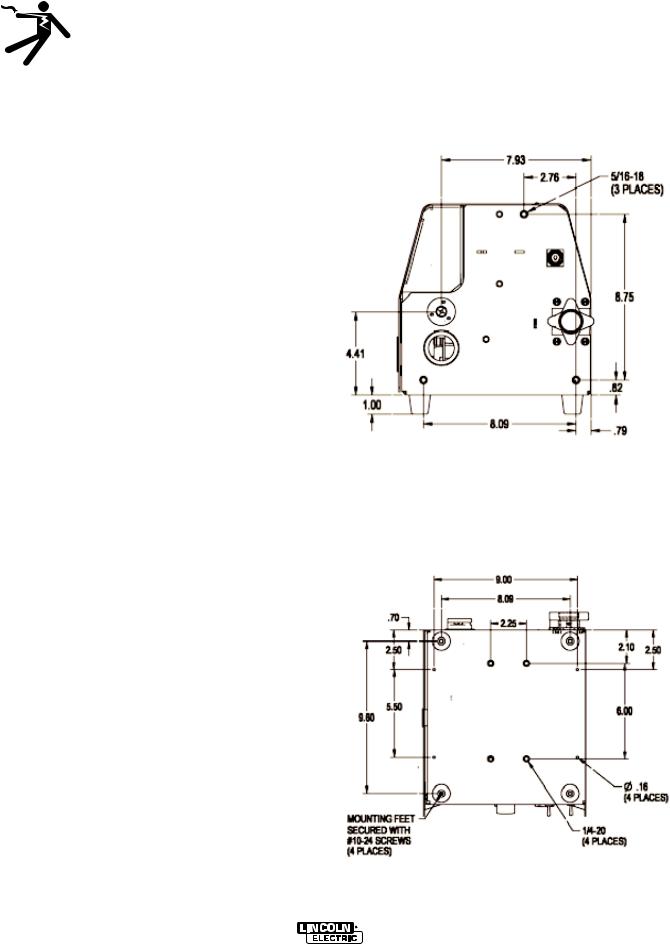
A-2 |
INSTALLATION |
A-2 |
|
|
|
SAFETY PRECAUTION
ELECTRIC SHOCK can kill.
•Only qualified personnel should perform this installation.
•Turn off the input power to the power source at the disconnect switch or fuse box before working on this equipment. Turn off the input power to any other equipment connected to the welding system at the disconnect switch or fuse box before working on this equipment.
•Do not touch electrically hot parts.
----------------------------------------------------------------------------------------
LOCATION
The LF-72 may be placed on a bench or mounted on top of a welding power source.
Place the LF-72 in a clean and dry location.
Do not stack the LF-72.
MOUNTING
For location and size, LF-72 Bench Model Rear Mounting Holes (See Figure A.1) and for Bottom Mounting Holes (See Figure A.2).
FIGURE A.1
FIGURE A.2
LF-72

A-3 |
INSTALLATION |
A-3 |
|
|
|
BENCH MOUNT
The LF-72 mounts in a variety of configurations. As shipped from the factory, the LF-72 is suitable for bench mounting or placing directly on top of the welding power source (CV-xxx and DC-xxx product family only).
Bench Mount
SWIVEL MOUNT
Both the standard duty bench model and heavy duty bench model may be mounted onto a swivel when a top a welding power source.
Swivel Kit and Bench Model, Standard Duty
Swivel Kit and Base Model LF-72
BOOM MOUNT
When boom mounting, remove the wire reel stand (if assembled) and secure the wire feeder directly to the desired surface.
SUSPENDED
Only suspend the wire feeder by the lift bail of the portability kit.
 WARNING
WARNING
Alternative methods for hanging the wire feeder must not be used unless insulation is provided between the wire feeder enclosure and the hanging device.
------------------------------------------------------------------------
LF-72
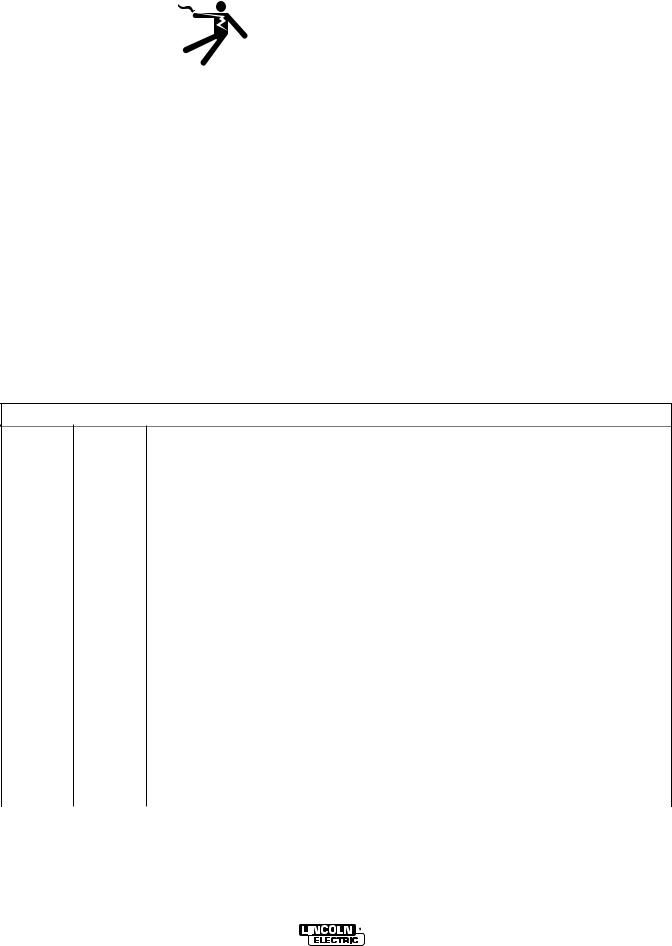
A-4 |
INSTALLATION |
A-4 |
|
|
|
|
SAFETY PRECAUTION |
|
|
ELECTRIC SHOCK can |
|
|
kill. |
|
|
• Only qualified personnel should |
|
|
perform this installation. |
|
|
• Turn off the input power to the power source at |
|
|
the disconnect switch or fuse box before work- |
|
|
ing on this equipment. Turn off the input power |
|
|
to any other equipment connected to the weld- |
|
|
ing system at the disconnect switch or fuse |
|
|
box before working on this equipment. |
|
|
• Do not touch electrically hot parts. |
|
|
---------------------------------------------------------------------- |
|
|
WELD CABLE SIZES |
|
Table A.1 has the copper cable sizes recommended for different currents and duty cycles. Lengths stipulated are the distance from the welder to work and back to the welder again. Cable sizes are increased for greater lengths primarily for the purpose of minimizing voltage in the welding circuit.
TABLE A.1
RECOMMENDED CABLE SIZES (RUBBER COVERED COPPER - RATED 75°C)**
CABLE SIZES FOR COMBINED LENGTHS OF ELECTRODE AND WORK CABLES
|
|
Percent |
|
0 to 50 Ft. |
|
|
50 to 100Ft. |
|
|
100 to 150 Ft. |
|
|
150 to 200 Ft. |
|
|
200 to 250 Ft. |
|
|
|
Duty |
|
|
|
|
|
|
31 to 48 m |
|
|
48 to 61 m |
|
|
61 to 76 m |
|
|
|
Amperes |
Cycle |
0 to 15 m |
|
|
15 to 31 m |
|
|
|
|
|
|
|
||||
|
|
|
|
|
|
|
|
|
|
|
|
|
|
|
|
|
|
200 |
60 |
|
2 |
|
|
2 |
|
|
2 |
|
|
1 |
|
|
1/0 |
|
|
200 |
100 |
|
2 |
|
|
2 |
|
|
2 |
|
|
1 |
|
|
1/0 |
|
|
225 |
20 |
|
4 or 5 |
|
|
3 |
|
|
2 |
|
|
1 |
|
|
1/0 |
|
|
225 |
40 & 30 |
|
3 |
|
|
3 |
|
|
2 |
|
|
1 |
|
|
1/0 |
|
|
250 |
30 |
|
3 |
|
|
3 |
|
|
2 |
|
|
1 |
|
|
1/0 |
|
|
|
|
|
|
|
|
|
|
|
|
|
|
|
|
|
|
|
|
250 |
40 |
|
2 |
|
|
2 |
|
|
1 |
|
|
1 |
|
|
1/0 |
|
|
250 |
60 |
|
1 |
|
|
1 |
|
|
1 |
|
|
1 |
|
|
1/0 |
|
|
250 |
100 |
|
1 |
|
|
1 |
|
|
1 |
|
|
1 |
|
|
1/0 |
|
|
300 |
60 |
|
1 |
|
|
1 |
|
|
1 |
|
|
1/0 |
|
|
2/0 |
|
|
|
|
|
|
|
|
|
|
|
|
|
|
|
|
|
|
|
|
325 |
100 |
|
2/0 |
|
|
2/0 |
|
|
2/0 |
|
|
2/0 |
|
|
3/0 |
|
|
350 |
60 |
|
1/0 |
|
|
1/0 |
|
|
2/0 |
|
|
2/0 |
|
|
3/0 |
|
|
400 |
60 |
|
2/0 |
|
|
2/0 |
|
|
2/0 |
|
|
3/0 |
|
|
4/0 |
|
|
400 |
100 |
|
3/0 |
|
|
3/0 |
|
|
3/0 |
|
|
3/0 |
|
|
4/0 |
|
|
500 |
60 |
|
2/0 |
|
|
2/0 |
|
|
3/0 |
|
|
3/0 |
|
|
4/0 |
|
|
|
|
|
|
|
|
|
|
|
|
|
|
|
|
|
|
|
|
|
|
|
|
|
|
|
|
|
|
|
|
|
|
|
|
|
|
**Tabled values are for operation at ambient temperatures of 40°C and below. Applications above 40°C may require cables larger than recommended, or cables rated higher than 75°C.
LF-72
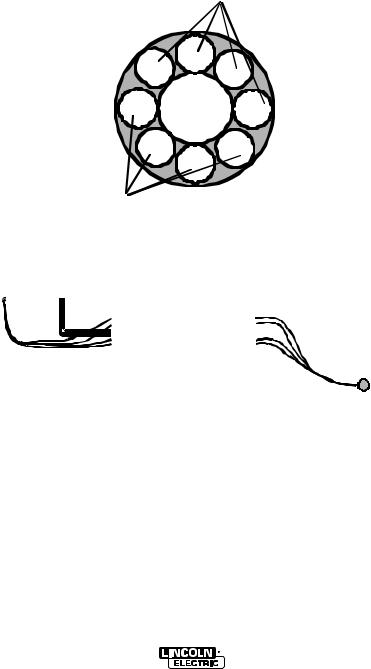
A-5 |
INSTALLATION |
A-5 |
|
|
|
COAXIAL WELD CABLES
Coaxial welding cables are specially designed welding cables for pulse welding or STT welding. Coaxial weld cables feature low inductance, allowing fast changes in the weld current. Regular cables have a higher inductance which may distort the pulse or STT wave shape. Inductance becomes more severe as the weld cables become longer.
Coaxial weld cables are recommended for all pulse and STT welding, especially when the total weld cable length (electrode cable + work cable) exceeds 50 feet (7.6m)
A coaxial weld cable is constructed by 8 small leads wrapped around one large lead. The large inner lead connects to the electrode stud on the power source and the electrode connection on the wire feeder. The small leads combine together to form the work lead, one end attached to the power source and the other end to the work piece. (See Coaxial weld Cable below.)
WELD CABLE CONNECTION
Connect a work lead of sufficient size between the proper output stud on the power source and the work. Be sure the connection to the work makes tight metal to metal electrical contact. Poor work lead connections can result in poor welding performance.
Work
|
|
Electrode |
|
|
|
Work |
|
|
|
|
|
|
|
|
Power Source |
|
|
|
|
Work Electrode |
|
|
|
|
|
|
|
Wire Feeder |
|
|
|
Coaxial Weld Cable |
|
|
|
|
|
|
Electrode |
|
|
|
|
|
|
|
|
|
|
|
|
|
|
|
|
|
|
|
Work |
LF-72

A-6 INSTALLATION A-6
ANALOG CONTROL CABLE
CONTROL CABLE CONNECTIONS
•All control cables can be connected end to end to extend their length.
The control cable connecting the wire feeder to the power source is specially made for the welding environment.
The wire feeder power requires overcurrent protection. Connect the wire feeder only to power sources with overcurrent protection of no more than 15 amps.
POWER SOURCE |
WIRE FEEDER |
|||||||
|
|
J |
A |
|
|
A |
J |
|
|
H I N |
KL BC |
CB |
L |
KNI |
H |
||
|
GF |
ME D |
DE |
MFG |
||||
|
|
|
|
|
|
|
|
|
|
PIN |
|
FUNCTION |
|
|
LEAD# |
|
|
|
|
|
|
|
|
|
|
|
|
A |
|
Unused |
|
|
------- |
|
|
|
B |
|
Reserved |
|
|
------- |
|
|
|
C |
|
Welding Output Control |
|
|
|
2 |
|
|
|
|
(trigger from feeder) |
|
|
|
|
|
|
D |
|
Welding Output Control |
|
|
|
4 |
|
|
|
|
(trigger from feeder) |
|
|
|
|
|
|
E |
|
Remote Voltage Control |
|
|
|
77 |
|
|
|
(“+” supply from feeder or remote) |
|
|
|
|
||
|
F |
|
Remote Voltage Control |
|
|
|
76 |
|
|
|
(control signal from feeder or remote) |
|
|
|
|
||
|
G |
|
Remote Voltage Control |
|
|
|
75 |
|
|
|
(“-” supply from feeder or remote) |
|
|
|
|
||
|
H |
|
Reserved |
|
|
|
|
|
|
I |
|
42 VAC |
|
|
|
41 |
|
|
J |
|
Reserve for Future Use. |
|
|
|
|
|
|
|
|
|
|
|
|
|
|
|
K |
|
42 VAC |
|
|
|
42 |
|
|
L |
|
Reserve for Future Use. |
|
|
|
|
|
|
|
|
|
|
|
|
|
|
|
M |
|
Unused |
|
|
------- |
|
|
|
N |
|
Electrode voltage from feeder |
|
|
67 |
|
|
|
|
|
|
|
|
|
|
|
Do not use more than 100 ft (30.5 m) of control cable between the wire feeder and power source.
LF-72
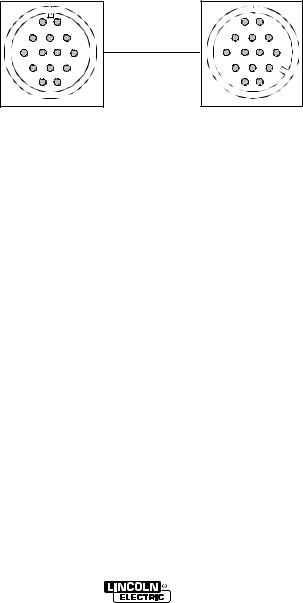
A-7 |
INSTALLATION |
A-7 |
|
|
|
ANALOG MILLER CONTROL CABLE ADAPTER K2335-1
This Lincoln Electric wire feeder may be mounted to a limited number of Miller Electric power sources. The Miller power source must have the amphenol pin definition shown in the table below for proper operation of the wire feeder.
Operation of Lincoln wire feeders on Miller power sources may result in lack of high speeds or reduce pull force on high wire feed speeds. Maximum wire feed speed for the LF-72 operating on a Miller power source is approximately 720ipm. Be sure the Miller power source provides 24 VAC to the wire feeder and has overcurrent protection of no more than 15 amps. The power source must not exceed 113VDC peak.
I |
J |
K A B |
B |
A |
K J |
I |
|
H G N |
ML |
D C |
C D |
L |
MN G H |
||
|
F |
E |
|
|
E |
F |
|
|
MILLER POWER SOURCE |
|
LINCOLN WIRE FEEDER |
Pin |
Function |
Pin |
Function |
|
|
|
|
A |
24 VAC to feeder |
I |
42 VAC feeder |
|
|
D |
Welding Output Control |
B |
Welding Output Control |
C |
Welding Output Control |
C |
+10VDC to feeder for remote control |
E |
Remote Voltage Control ("+" supply, from |
|
|
|
power source) |
D |
Remote control common |
G |
Remote Voltage Control ("-" supply, from |
|
|
|
power source) |
E |
0-10VDC from feeder for remote control. |
F |
Remote Voltage Control (control signal from |
|
|
|
feeder or remote.) |
F |
Current feedback to feeder. |
J |
Reserved for future use. |
|
Scaled 0-10V. 1 V = 100 amps. |
|
|
|
Referenced to pin D. |
|
|
G |
24 VAC common. |
K |
42 VAC to feeder |
H |
Arc Voltage feedback to feeder. |
L |
Reserved for future use. |
|
Scaled 0-10V. 1 V = 10 Arc volts. |
|
|
|
Referenced to pin D. |
|
|
I |
|
|
|
J |
|
|
|
K |
|
|
|
L |
|
|
|
M |
|
|
|
N |
|
N |
Electrode voltage to power source (67) |
|
|
|
|
Miller is a registered trademark not owned or licensed by The Lincoln Electric Company.
LF-72
